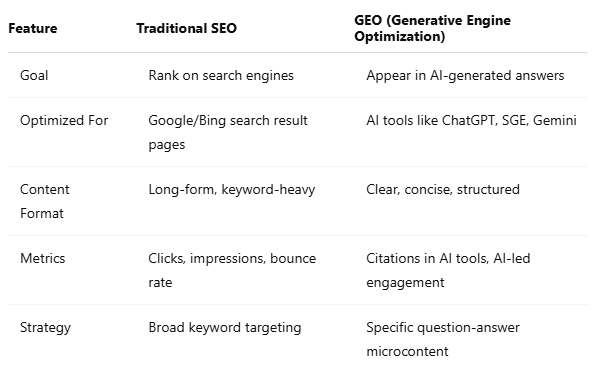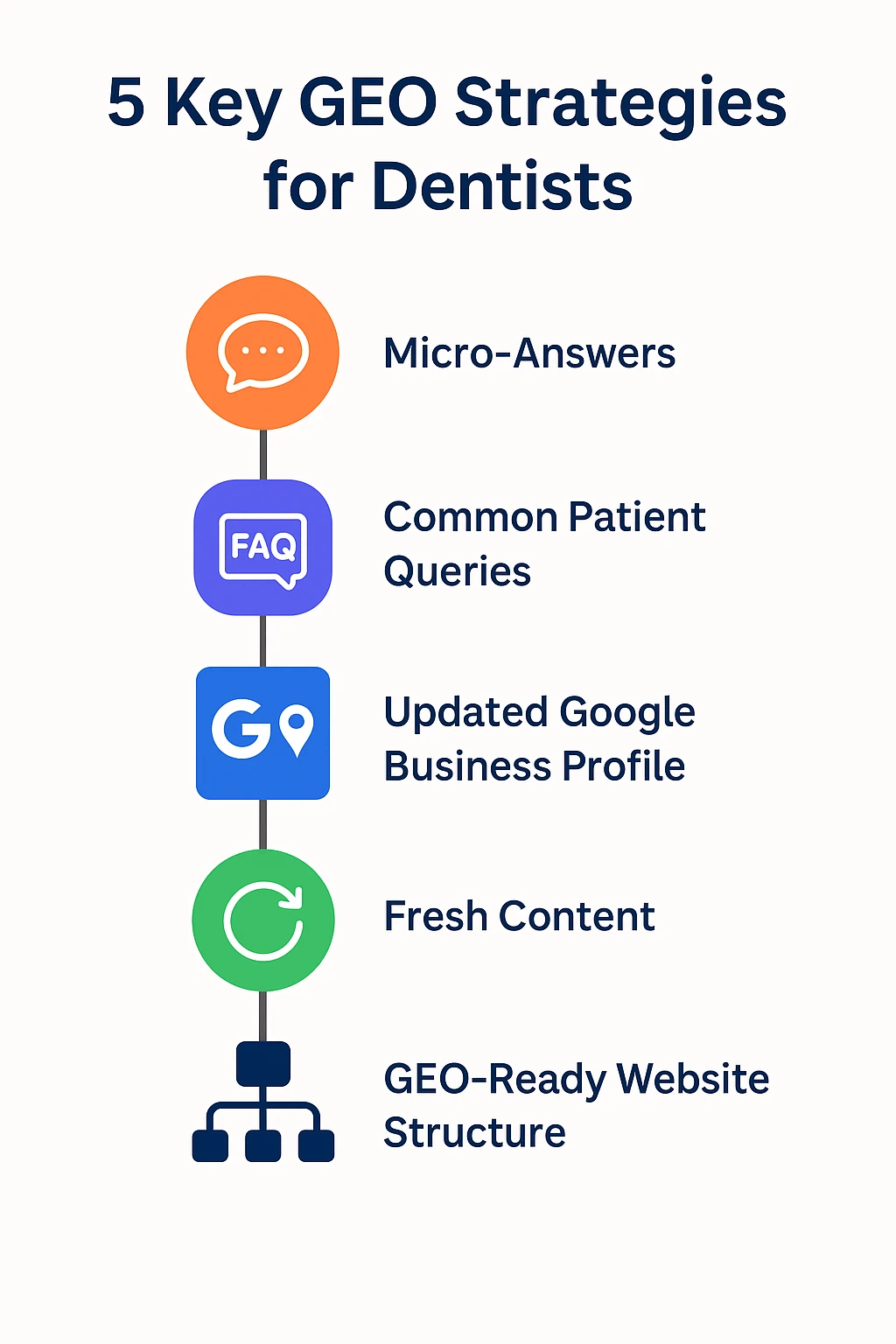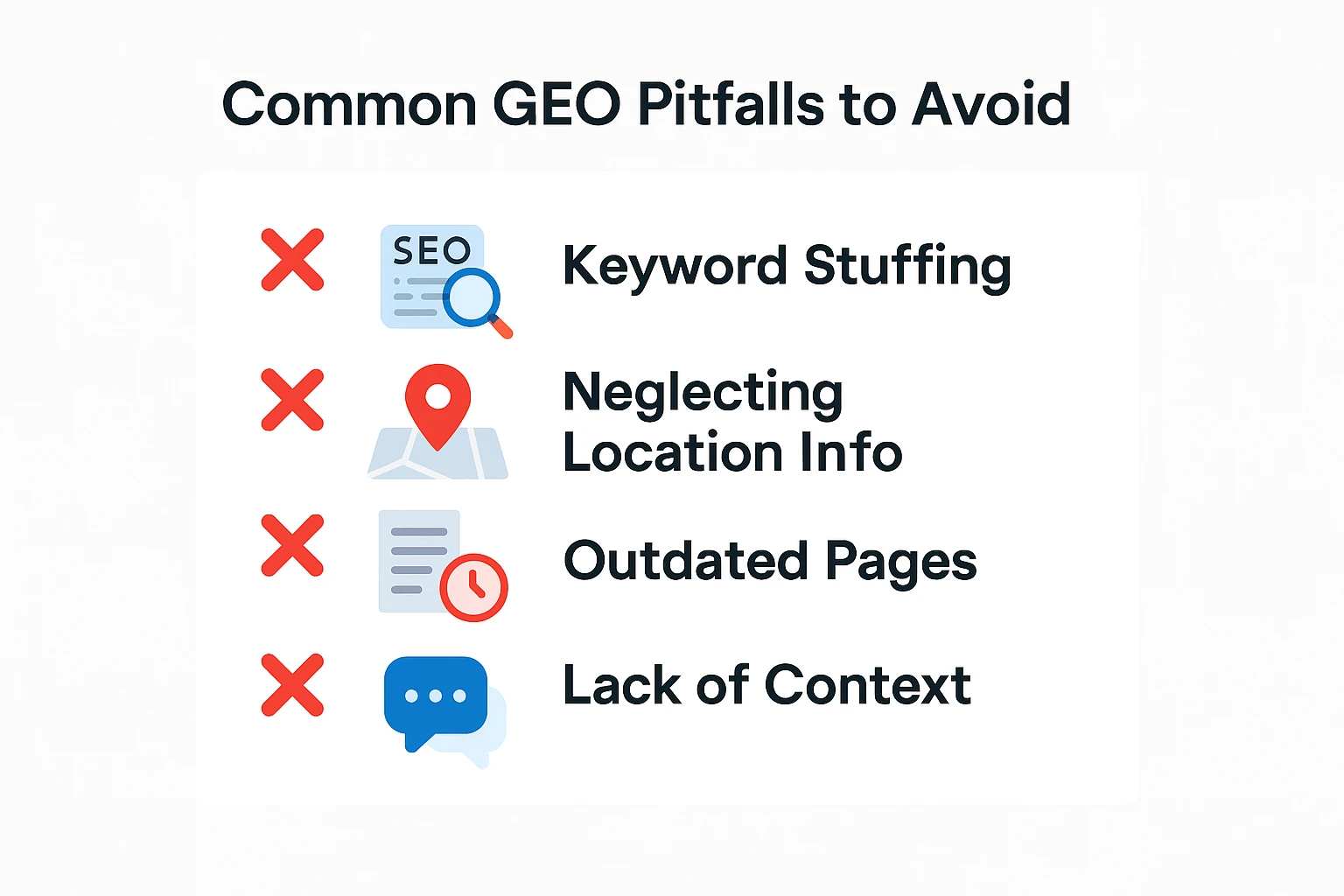
Limited time offer – Zero commission on Google Ads
You only pay what you spend on your Google Ads, no commission or hidden charges
For years, the goal of digital marketing for your dental practice has been clear: get to the top of Google’s search results. You’ve invested in search engine optimization (SEO), carefully selected keywords, and worked to build a website that would rank high on that coveted first page. But the ground is shifting beneath our feet. The simple list of blue links is rapidly being replaced by something new, something conversational, and something powered by artificial intelligence. Welcome to the era of generative engine optimization (GEO).
If you’re not yet familiar with this term, you’re not alone. But understanding and implementing GEO is about to become critical to future-proof your practice’s digital presence. GEO is the process of optimizing your digital presence to be featured directly in the AI-generated answers provided by platforms like Google's Search Generative Experience (SGE), ChatGPT, and Microsoft CoPilot. Patients are no longer just searching; they are asking questions and getting detailed, synthesized answers without ever having to click on a website. GEO is the strategy that ensures your practice’s information is a key source for those answers.
The change in patient behavior is the single most important reason to pay attention to GEO. Patients today rely heavily on mobile and voice-based searches for immediate healthcare answers. Imagine a potential patient in your city using their phone to ask, "How much does Invisalign cost in San Diego?" In the past, they would type this into Google and browse the top-ranking dental websites. Today, they expect an instant, direct answer.
The AI will then scan the web, pull information from various trusted sources, and present a consolidated summary. It might say, "Invisalign in San Diego typically costs between $3,500 and $7,000. Factors influencing the cost include the complexity of your case. Practices like [Your Practice Name] offer free consultations to provide an exact quote."
In this scenario, the patient received their answer without a single click. This is the "zero-click" reality of the new search landscape, and it's more common than you think. Recent studies show that more than 50% of Google searches end without a click on any search result. If your website isn't optimized for the AI to find and feature your information, you become invisible. The good news? Generative AI search optimization levels the playing field. An AI engine is less concerned with a website's overall size and more interested in the clarity and authority of the information it provides. A solo practice with a well-structured website can have its content featured just as easily as a large DSO.
It’s easy to get lost in the alphabet soup of digital marketing terms, but understanding how GEO complements traditional SEO is key. SEO remains the essential foundation for building authority, while GEO is the next layer designed for the new AI-driven landscape.

For dentists, this means you can’t just rely on SEO alone. You need a comprehensive approach that includes a strong dental SEO services foundation complemented by a forward-thinking GEO strategy.
Generative AI models are information-hungry, but they don't read your website like a human does. They are programmed to find the most direct, clear, and authoritative micro-answers to specific questions. They don't just see a page about "dental crowns"; they look for specific data points within that page.
For instance, when a user asks, "How long does a dental crown last?", the AI scans websites looking for a sentence that reads something like, "A well-maintained dental crown can last between 10 to 15 years, depending on the material and the patient's oral hygiene habits."
It’s not looking for a lengthy, philosophical discussion. It wants a direct, quotable fact. Similarly, for the query "Can you whiten sensitive teeth?" the AI will favor a site that clearly states, "Yes, teeth whitening is possible for patients with sensitive teeth.” We use specialized gels with lower peroxide levels and desensitizing agents to ensure a comfortable experience." This is why clean formatting and clear language are paramount for being featured.

Adopting a GEO mindset doesn't require you to throw out your entire marketing plan. Instead, it involves refining your existing content and approach. Here are some powerful strategies you can implement.
1) Create Micro-Answers Within Your Service Pages: Go through your key service pages (implants, veneers, cleanings, etc.) and add short, 2-3 sentence summaries that answer the most important questions. These micro-answers, written in a friendly, conversational tone, are exactly what AI models are looking for.
2) Optimize for Common Patient Queries: Brainstorm the questions you hear every day during consultations. Turn those into on-site Q&A sections or blog posts. Structure each answer clearly and concisely. This positions you as an authority and provides perfect fodder for AI. Exploring how AI tools in dentistry enhance patient care can give you more ideas for educational content.
3) Keep Your Google Business Profile (GBP) Meticulously Updated: Your GBP is a primary data source for AI in local searches. Write a clear, service-focused business description. Use the Q&A feature to proactively answer common questions. Fill out every single service you offer with a detailed description. A robust GBP is the cornerstone of any local listing strategy for doctors.
4) Use Fresh, Updated Content: AI tools prioritize recent and reliable information. Stale service pages won’t be favored. Review and update your core pages at least once every 3-4 months, especially if you introduce new technology or treatments. Blending AI updates into your content is a key part of modern AI dental marketing strategies.
5) Invest in a GEO-Ready Website Structure: Your website's design is crucial. A logical structure with clear headings, fast load times, and proper schema markup makes your site easy for AI to crawl and understand. If your site is outdated, consider investing in a modern web design that is built for the AI era.
1) A cosmetic dentist in Austin, TX, includes a well-written FAQ on their veneers page answering, "How safe are porcelain veneers?" This short, direct answer gets picked up by Bing CoPilot and is featured in a search result, with a link back to their website.
2) An endodontist in Chicago, IL, updates their blog monthly with posts answering real patient questions like, "Do root canals hurt?" Their clear micro-answer is now frequently pulled into Google SGE summaries for local searches.
3) A pediatric dentist in Orlando, FL, lists typical treatment timelines under each service. When a parent asks ChatGPT, "How long do baby teeth fillings last?" the AI summarizes their content because it's structured, clear, and helpful.
Measuring the ROI of GEO is different from traditional SEO. Since the goal isn't always a click, your metrics need to evolve.
1) AI Citations: This is your primary success metric. Manually search for your services and related questions in tools like Google SGE and ChatGPT. See if your practice is mentioned or if your content appears in the AI-generated response.
2) Increased Branded Search: As more people see your practice name in AI answers, they will start searching for you directly. Monitor the volume of searches for your practice name in Google Search Console.
3) Impression Growth: Even if clicks remain flat, a steady growth in impressions for question-based queries is a strong sign that your content is achieving visibility within AI-enhanced search results.
4) Track Conversions: Ultimately, the most important metric is new patient calls and appointment requests. An effective GEO strategy should lead to more qualified leads, which you can capture with tools like an AI chatbot for doctors on your website.

As you venture into GEO, be mindful of these common mistakes that can render your efforts ineffective:
1) Keyword Stuffing: AI tools prioritize clarity and natural language, not keyword repetition.
2) Neglecting Location Relevance: Vague statements like "we’re the best" are useless. You must specify where you are the best (e.g., "a top-rated periodontist in Dallas, TX").
3) Outdated Service Pages: A blog post from 2018 is unlikely to be cited by today's AI systems. Keep your information current.
4) Missing Context: Answers that are too short or vague without supporting context on the page may be overlooked entirely.
Ready to get started? Here is a simple checklist to begin optimizing your practice for generative AI today.
1) Identify Top Patient Questions: List the top 10 questions you get for your most valuable services.
2) Write Concise Micro-Answers: Draft a 2-3 sentence answer for each question using a friendly, conversational tone.
3) Update Your Website: Add these Q&As directly into their corresponding service pages and blog posts.
4) Refresh Content Regularly: Schedule a quarterly review to keep your website content fresh and accurate. Consider using AI tools like ChatGPT's image generator to create new visuals that keep your pages engaging.
5) Monitor and Adapt: Periodically check how your content appears in AI tools and adjust your strategy based on what is performing well.
Generative Engine Optimization isn’t a passing trend—it’s the new foundation for online visibility. While SEO still plays a crucial role, GEO ensures your practice is seen and trusted by the AI systems shaping how patients search today. To learn more about this synergy, read our guide on how to boost your dental practice with AI search optimization.
Dentists who embrace GEO will not only gain an early advantage but will also be future-proofing their marketing for the next wave of digital discovery. The sooner you act, the more visible your practice becomes—not just to search engines, but to the intelligent systems guiding patient decisions.
Get in touch with our healthcare marketing expert